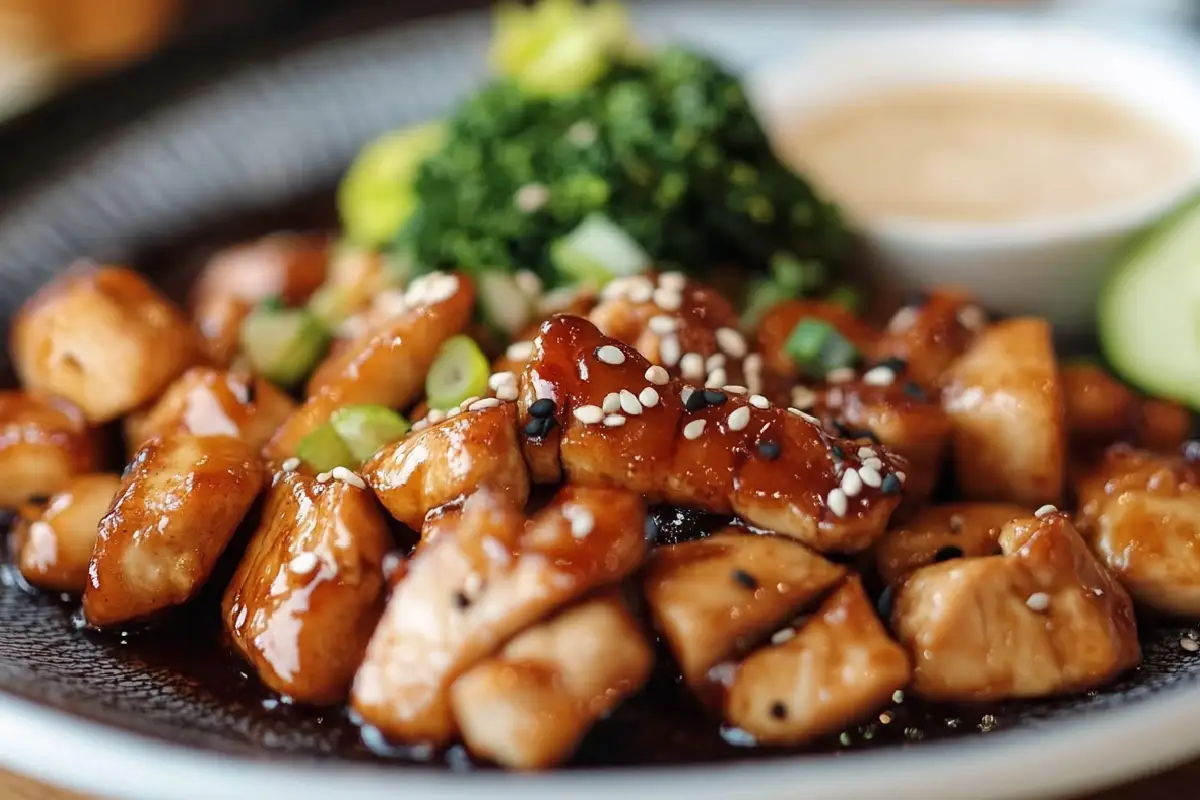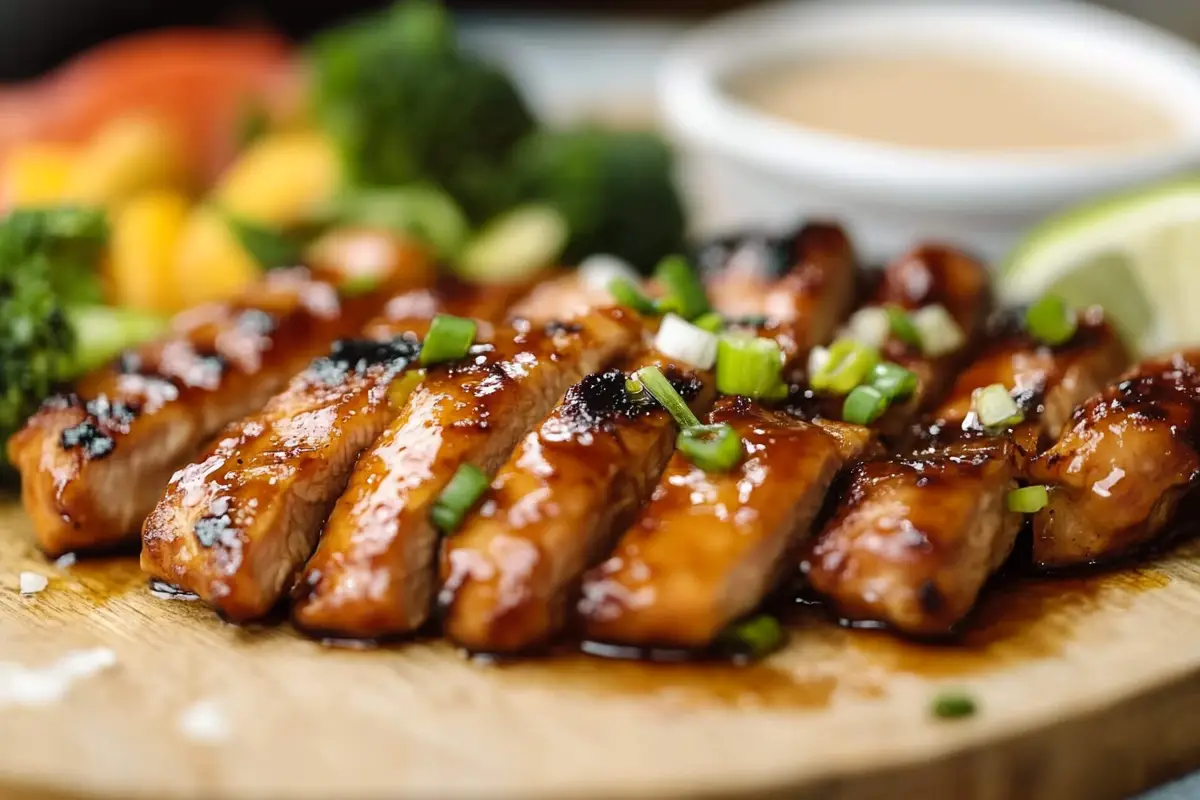One of the key reasons Hibachi dishes are so flavorful is the balance that the sauces bring to the grilled food. The high-heat cooking method used in Hibachi grilling often results in a smoky, charred flavor, and the accompanying sauces are designed to complement and enhance that flavor without overpowering it.
Why Sauces Are Essential in Hibachi Cooking
The interplay between smoky grilled meats and flavorful sauces is what sets Hibachi cuisine apart. Whether it’s steak, shrimp, or vegetables, the sauce adds moisture, depth, and complexity to the food. Without these sauces, many Hibachi dishes might taste dry or too smoky. In fact, in many Japanese restaurants, sauces are considered as important as the grilled items themselves because they bring the entire dish together.
For instance, a sharp Ginger sauce can cut through the richness of grilled steak, balancing the flavors, while a sweet Yum Yum sauce can pair perfectly with shrimp or chicken, adding a creamy contrast to the savory grilled food. This balance of flavors, textures, and temperatures is what makes Hibachi dining such a dynamic experience.
Additional Types of Hibachi Sauces
Let’s look at a few more Hibachi sauce variations and their specific uses:
1. Ponzu Sauce
Ponzu sauce is a citrus-based sauce made from soy sauce, rice vinegar, lemon or lime juice, and sometimes a touch of mirin. It’s a light, tangy sauce that works well as a dipping sauce for seafood and vegetables. Ponzu sauce adds a refreshing, zesty element to grilled dishes, making it perfect for balancing rich, fatty meats like salmon or tuna.
2. Miso Sauce
Miso sauce is a rich, savory sauce made from miso paste, soy sauce, and sometimes sake or mirin for sweetness. The fermented soybean paste gives the sauce a deep, umami flavor that pairs beautifully with grilled meats and vegetables. It’s commonly used as a marinade for beef, pork, or even tofu before grilling.
3. Garlic Butter Sauce
Although not traditionally Japanese, garlic butter sauce has become a popular accompaniment to Hibachi dishes in Westernized Japanese steakhouses. Made from melted butter, garlic, and a pinch of parsley, this sauce adds a creamy, savory element to dishes, especially shrimp and chicken. The butter enhances the richness of the grilled meats, while the garlic adds an aromatic touch.
4. Soy Sesame Dipping Sauce
This simple yet flavorful sauce is made from soy sauce, sesame oil, garlic, and a dash of sugar. The toasted sesame oil gives the sauce a nutty flavor, while the soy sauce and sugar balance the sweetness and saltiness. It’s often used as a dipping sauce for chicken or beef, adding a rich umami note that enhances the grilled flavor.
5. Wasabi Cream Sauce
For those who enjoy a bit of heat, wasabi cream sauce offers a mild but spicy kick. Made from wasabi paste, mayonnaise, and sometimes a splash of soy sauce, this creamy sauce is perfect for dipping grilled shrimp or scallops. The heat from the wasabi is mellowed out by the mayonnaise, making it a unique and flavorful addition to any Hibachi dish.
Creating Hibachi Sauces at Home: Tips and Tricks

Making Hibachi sauces at home is not only easy, but it also allows you to tailor the flavors to your preferences. Here are some tips to keep in mind when making your own Hibachi sauces:
- Use Fresh Ingredients: Freshly grated ginger, garlic, and freshly squeezed citrus juice can make all the difference in your sauces. They bring out vibrant flavors that are often lost in store-bought versions.
- Balance Flavors: The key to a great Hibachi sauce is balancing the flavors of salty, sweet, sour, and umami. Don’t be afraid to taste as you go and adjust the ingredients to suit your preferences. For example, if you find your sauce too salty, a touch of sugar or citrus can balance it out.
- Simmer for Depth: For richer, thicker sauces, simmer your ingredients over medium heat to reduce and intensify the flavors. This is especially useful for Teriyaki or ginger-based sauces that benefit from a slightly thicker consistency.
- Customize the Heat: Hibachi sauces can range from mild to spicy depending on your taste. If you enjoy heat, don’t be afraid to add Sriracha, chili oil, or even wasabi to give your sauce a fiery kick.
- Experiment with Add-Ins: A splash of fish sauce, sesame seeds, or even a hint of honey can elevate your Hibachi sauce to the next level. Don’t hesitate to get creative and try new flavor combinations.
Pairing Hibachi Sauces with Different Proteins
Hibachi cooking offers a wide range of protein options, from steak and chicken to shrimp and scallops. Let’s explore the best sauce pairings for these dishes:
1. Steak and Ginger Sauce
Grilled steak is rich and flavorful, and it pairs beautifully with a ginger sauce that adds a fresh, spicy contrast. The tangy notes of soy sauce and ginger cut through the richness of the beef, creating a balanced bite. This is why ginger sauce is often served alongside Hibachi steak in restaurants.
2. Chicken and Yum Yum Sauce
Yum Yum sauce is creamy, tangy, and slightly sweet, making it the perfect complement to grilled chicken. The sauce’s smooth texture adds richness, while its mild flavor lets the chicken’s smoky taste shine through. It’s also a favorite among kids, making it a family-friendly option for Hibachi meals.
3. Shrimp and Ponzu Sauce
For shrimp, a light, citrusy sauce like ponzu works best. The bright flavors of lemon or lime juice, combined with the savory notes of soy sauce and rice vinegar, enhance the natural sweetness of grilled shrimp without overpowering it. Ponzu sauce’s acidity also balances out the shrimp’s richness.
4. Scallops and Wasabi Cream Sauce
Wasabi cream sauce adds a delightful kick to grilled scallops. The heat from the wasabi complements the sweetness of the scallops, while the creamy mayonnaise base tempers the spice. This combination results in a well-rounded dish that’s both flavorful and exciting.
5. Vegetables and Sesame Sauce
Grilled vegetables like zucchini, mushrooms, and onions benefit from the rich, nutty flavor of sesame sauce. The sesame oil adds a toasty aroma, while the soy sauce and garlic bring out the savory notes in the vegetables. This pairing is especially delicious when served alongside a plate of Hibachi fried rice.
Enhancing the Hibachi Experience at Home
If you’re looking to recreate the Hibachi dining experience at home, here are a few tips to help you elevate your meal:
1. Use a Cast-Iron Skillet
While a traditional Hibachi grill uses a flat iron surface, you can achieve similar results at home by using a cast-iron skillet. The high heat of the skillet will give your meats and vegetables that characteristic char and smoky flavor.
2. Prep Your Ingredients in Advance
In Hibachi cooking, timing is everything. Make sure all your ingredients are prepped and ready to go before you start cooking. This includes chopping vegetables, marinating meats, and having your sauces ready for dipping and glazing.
3. Cook in Small Batches
To avoid overcrowding the skillet or grill, cook your ingredients in small batches. This allows each item to cook evenly and achieve a nice sear without steaming.
4. Serve with Fried Rice or Noodles
Hibachi meals are often served with fried rice or stir-fried noodles, which soak up the delicious sauces. You can easily prepare these sides at home by stir-frying rice or noodles with garlic, soy sauce, sesame oil, and a touch of mirin or sake.
5. Presentation Matters
Part of the fun of Hibachi dining is the presentation. Serve your grilled meats and vegetables on a hot plate, and garnish with sesame seeds, scallions, or a squeeze of lemon. Don’t forget to serve your sauces in small bowls for dipping.
More FAQs About Hibachi Sauce
Let’s cover a few more questions that people often ask about Hibachi sauce and its uses:
How can I make Hibachi sauce gluten-free?
To make Hibachi sauce gluten-free, simply use a gluten-free soy sauce or tamari as the base. Most other ingredients, like garlic, ginger, and sesame oil, are naturally gluten-free.
Can Hibachi sauce be used in slow cooking?
Yes, Hibachi sauce can be used in slow cooking as a marinade or sauce. Simply pour the sauce over your meat or vegetables and cook on low for several hours. The sauce will help to tenderize the meat and infuse it with flavor.
Is Hibachi sauce suitable for vegetarians or vegans?
Most Hibachi sauces are naturally vegetarian, and many can easily be made vegan. To ensure your sauce is vegan, use soy sauce, ginger, garlic, and vegetable-based ingredients. If using miso or other fermented products, make sure they don’t contain animal-derived ingredients.
Can I use Hibachi sauce for grilling on a BBQ?
Absolutely! Hibachi sauce works wonderfully as a marinade or glaze for meats and vegetables on a BBQ grill. Just be mindful of the sugar content in the sauce—sauces with higher sugar content can burn quickly on a hot grill, so brush them on during the last few minutes of cooking.
Conclusion

Hibachi sauces are essential to the rich, savory flavors that make Hibachi cooking so irresistible. Whether you’re enjoying the light tang of ponzu sauce or the creamy richness of Yum Yum sauce, each sauce plays a vital role in enhancing the grilled dishes we love.
By experimenting with different sauce variations and techniques, you can bring the Hibachi experience to your own kitchen and customize your meals to your liking. From marinating meats to serving as a dipping sauce, Hibachi sauce is versatile, easy to make, and delicious.
For more exciting recipes and culinary ideas, head over to Crystal Recipes and explore the endless possibilities that sauces and condiments bring to your meals!

